Communication in Employee Knowledge Development: A Detailed Analysis
VerifiedAdded on 2023/06/10
|13
|3196
|254
Report
AI Summary
This report delves into the critical role of effective communication in employee knowledge development within organizations. It emphasizes the importance of internal communication in employee education and training, highlighting the impact of communication on employee induction and the ongoing development of newly recruited staff. The report discusses various training methods, including team-based and self-directed learning, and analyzes the stakes of communication in employee induction. It explores the double dimension of communication in employee education programs, examining both the transmission of content and the understanding of relationships. The report also addresses the role of Human Resource Management in employee development and provides insights into communication trends within organizations. The analysis underscores the significance of communication in fostering a productive and competitive work environment.
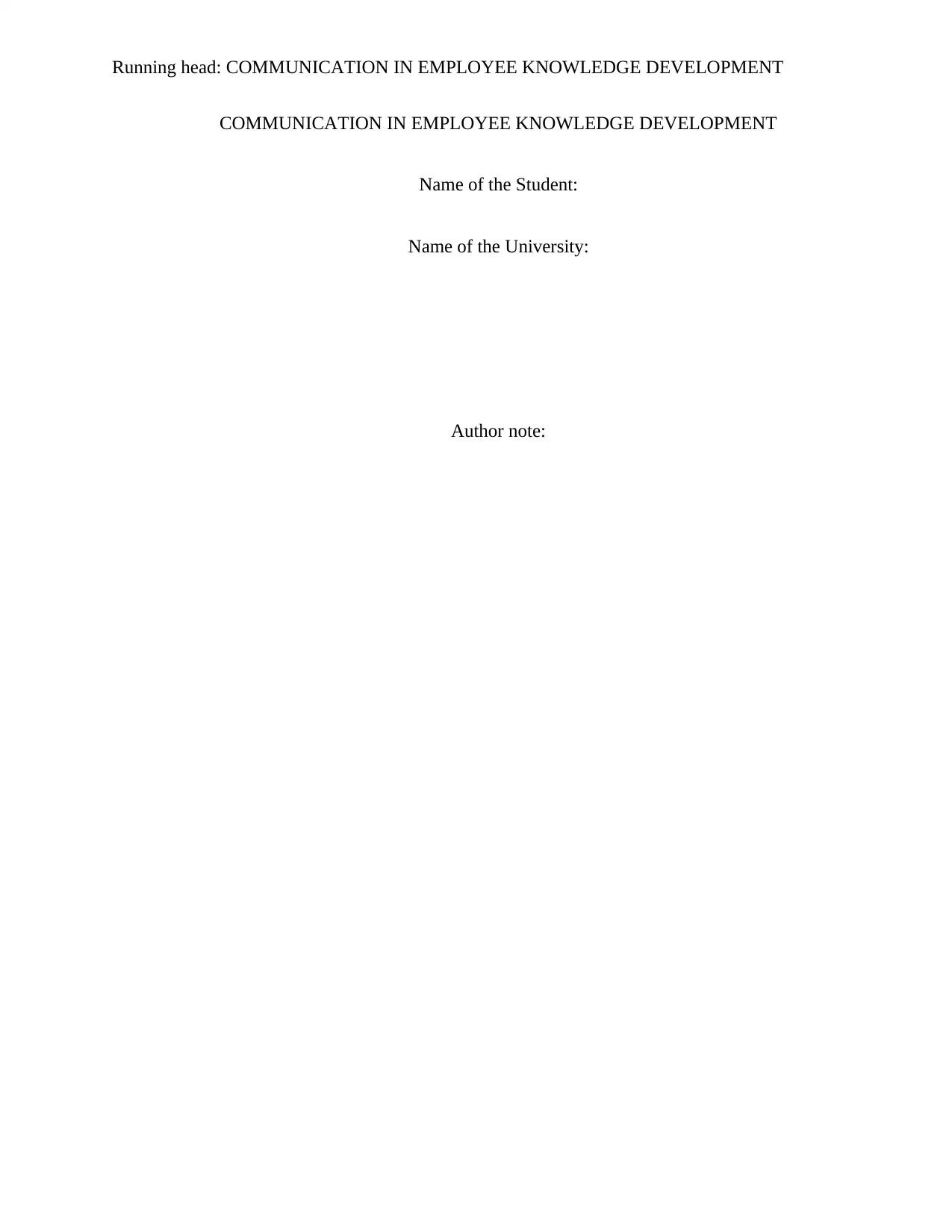
Running head: COMMUNICATION IN EMPLOYEE KNOWLEDGE DEVELOPMENT
COMMUNICATION IN EMPLOYEE KNOWLEDGE DEVELOPMENT
Name of the Student:
Name of the University:
Author note:
COMMUNICATION IN EMPLOYEE KNOWLEDGE DEVELOPMENT
Name of the Student:
Name of the University:
Author note:
Paraphrase This Document
Need a fresh take? Get an instant paraphrase of this document with our AI Paraphraser
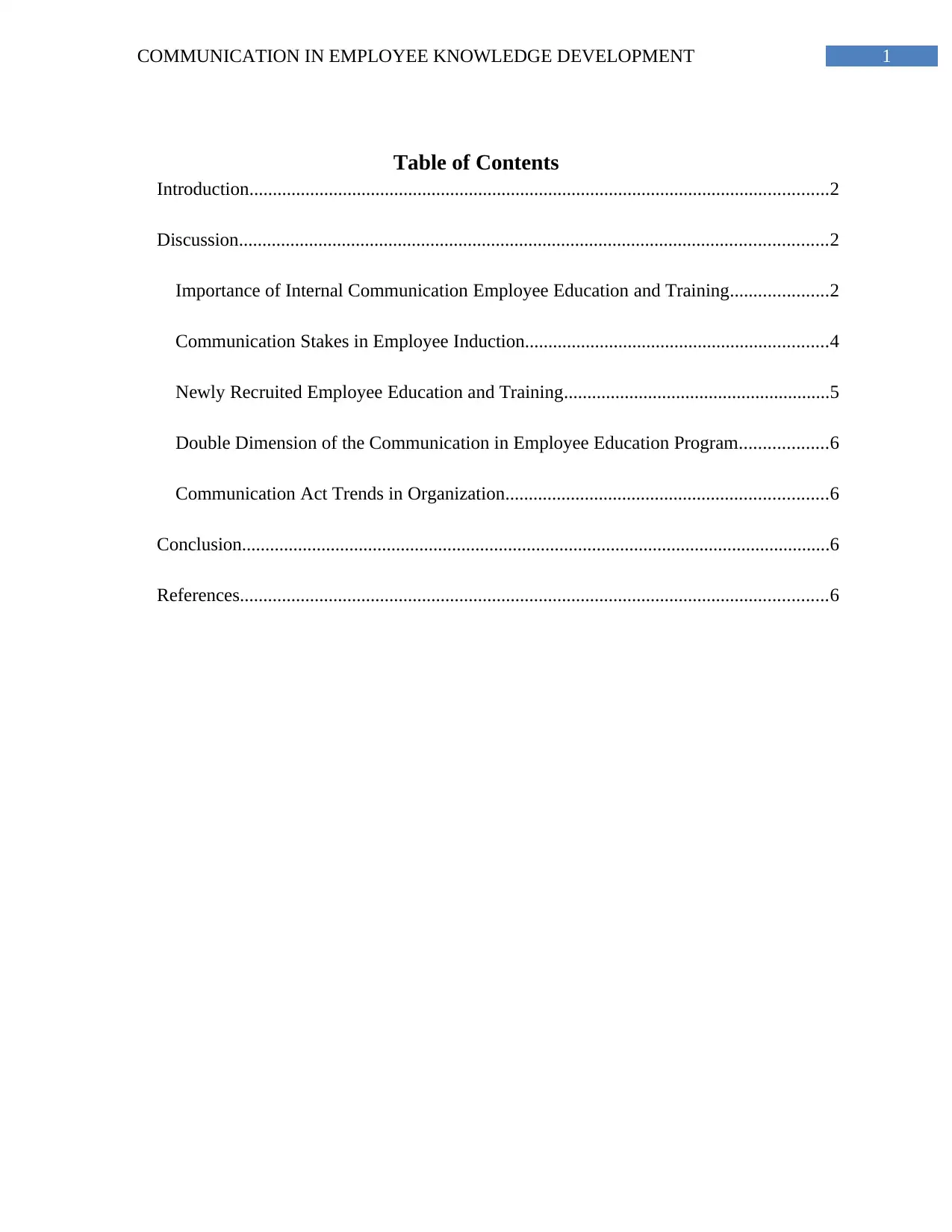
1COMMUNICATION IN EMPLOYEE KNOWLEDGE DEVELOPMENT
Table of Contents
Introduction............................................................................................................................2
Discussion..............................................................................................................................2
Importance of Internal Communication Employee Education and Training.....................2
Communication Stakes in Employee Induction.................................................................4
Newly Recruited Employee Education and Training.........................................................5
Double Dimension of the Communication in Employee Education Program...................6
Communication Act Trends in Organization.....................................................................6
Conclusion..............................................................................................................................6
References..............................................................................................................................6
Table of Contents
Introduction............................................................................................................................2
Discussion..............................................................................................................................2
Importance of Internal Communication Employee Education and Training.....................2
Communication Stakes in Employee Induction.................................................................4
Newly Recruited Employee Education and Training.........................................................5
Double Dimension of the Communication in Employee Education Program...................6
Communication Act Trends in Organization.....................................................................6
Conclusion..............................................................................................................................6
References..............................................................................................................................6
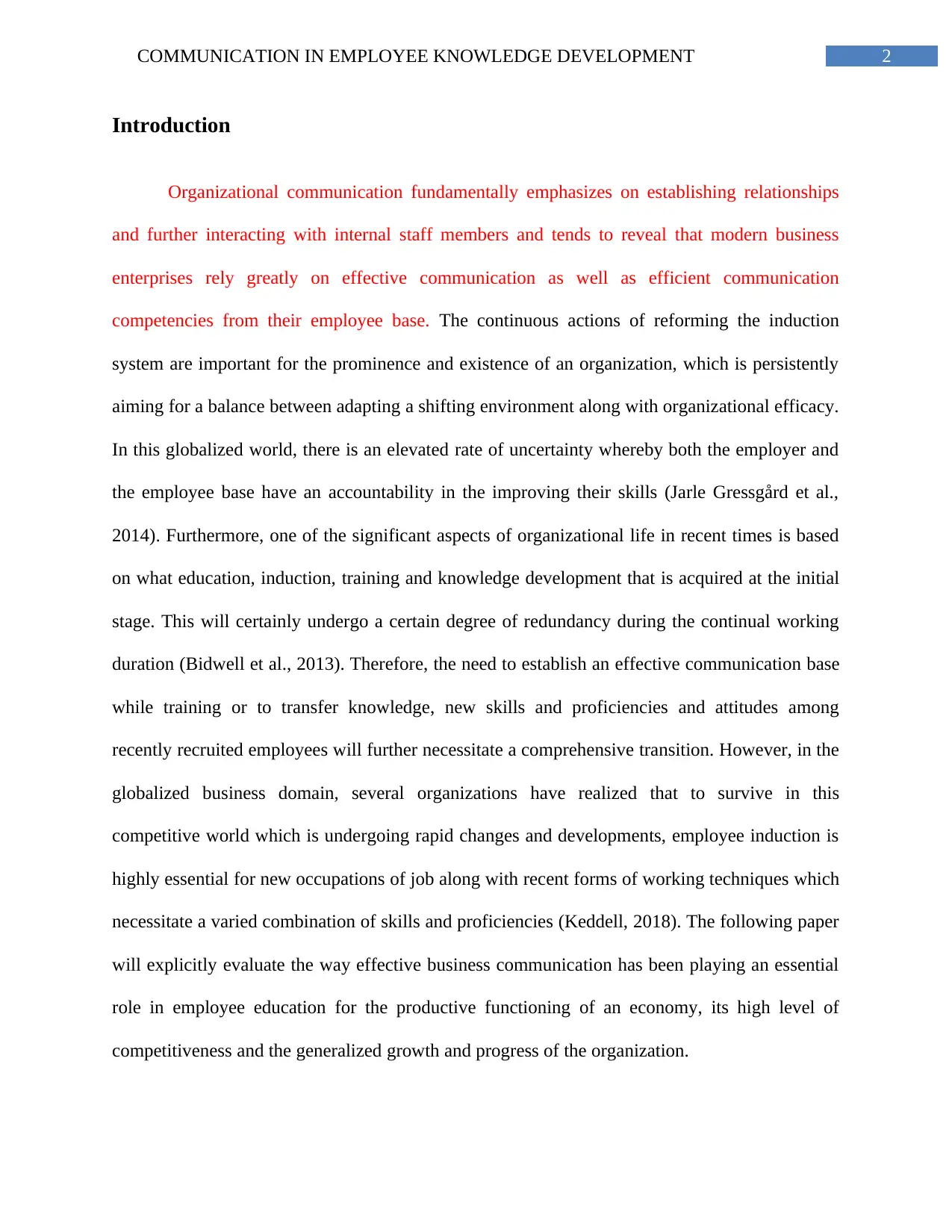
2COMMUNICATION IN EMPLOYEE KNOWLEDGE DEVELOPMENT
Introduction
Organizational communication fundamentally emphasizes on establishing relationships
and further interacting with internal staff members and tends to reveal that modern business
enterprises rely greatly on effective communication as well as efficient communication
competencies from their employee base. The continuous actions of reforming the induction
system are important for the prominence and existence of an organization, which is persistently
aiming for a balance between adapting a shifting environment along with organizational efficacy.
In this globalized world, there is an elevated rate of uncertainty whereby both the employer and
the employee base have an accountability in the improving their skills (Jarle Gressgård et al.,
2014). Furthermore, one of the significant aspects of organizational life in recent times is based
on what education, induction, training and knowledge development that is acquired at the initial
stage. This will certainly undergo a certain degree of redundancy during the continual working
duration (Bidwell et al., 2013). Therefore, the need to establish an effective communication base
while training or to transfer knowledge, new skills and proficiencies and attitudes among
recently recruited employees will further necessitate a comprehensive transition. However, in the
globalized business domain, several organizations have realized that to survive in this
competitive world which is undergoing rapid changes and developments, employee induction is
highly essential for new occupations of job along with recent forms of working techniques which
necessitate a varied combination of skills and proficiencies (Keddell, 2018). The following paper
will explicitly evaluate the way effective business communication has been playing an essential
role in employee education for the productive functioning of an economy, its high level of
competitiveness and the generalized growth and progress of the organization.
Introduction
Organizational communication fundamentally emphasizes on establishing relationships
and further interacting with internal staff members and tends to reveal that modern business
enterprises rely greatly on effective communication as well as efficient communication
competencies from their employee base. The continuous actions of reforming the induction
system are important for the prominence and existence of an organization, which is persistently
aiming for a balance between adapting a shifting environment along with organizational efficacy.
In this globalized world, there is an elevated rate of uncertainty whereby both the employer and
the employee base have an accountability in the improving their skills (Jarle Gressgård et al.,
2014). Furthermore, one of the significant aspects of organizational life in recent times is based
on what education, induction, training and knowledge development that is acquired at the initial
stage. This will certainly undergo a certain degree of redundancy during the continual working
duration (Bidwell et al., 2013). Therefore, the need to establish an effective communication base
while training or to transfer knowledge, new skills and proficiencies and attitudes among
recently recruited employees will further necessitate a comprehensive transition. However, in the
globalized business domain, several organizations have realized that to survive in this
competitive world which is undergoing rapid changes and developments, employee induction is
highly essential for new occupations of job along with recent forms of working techniques which
necessitate a varied combination of skills and proficiencies (Keddell, 2018). The following paper
will explicitly evaluate the way effective business communication has been playing an essential
role in employee education for the productive functioning of an economy, its high level of
competitiveness and the generalized growth and progress of the organization.
⊘ This is a preview!⊘
Do you want full access?
Subscribe today to unlock all pages.

Trusted by 1+ million students worldwide
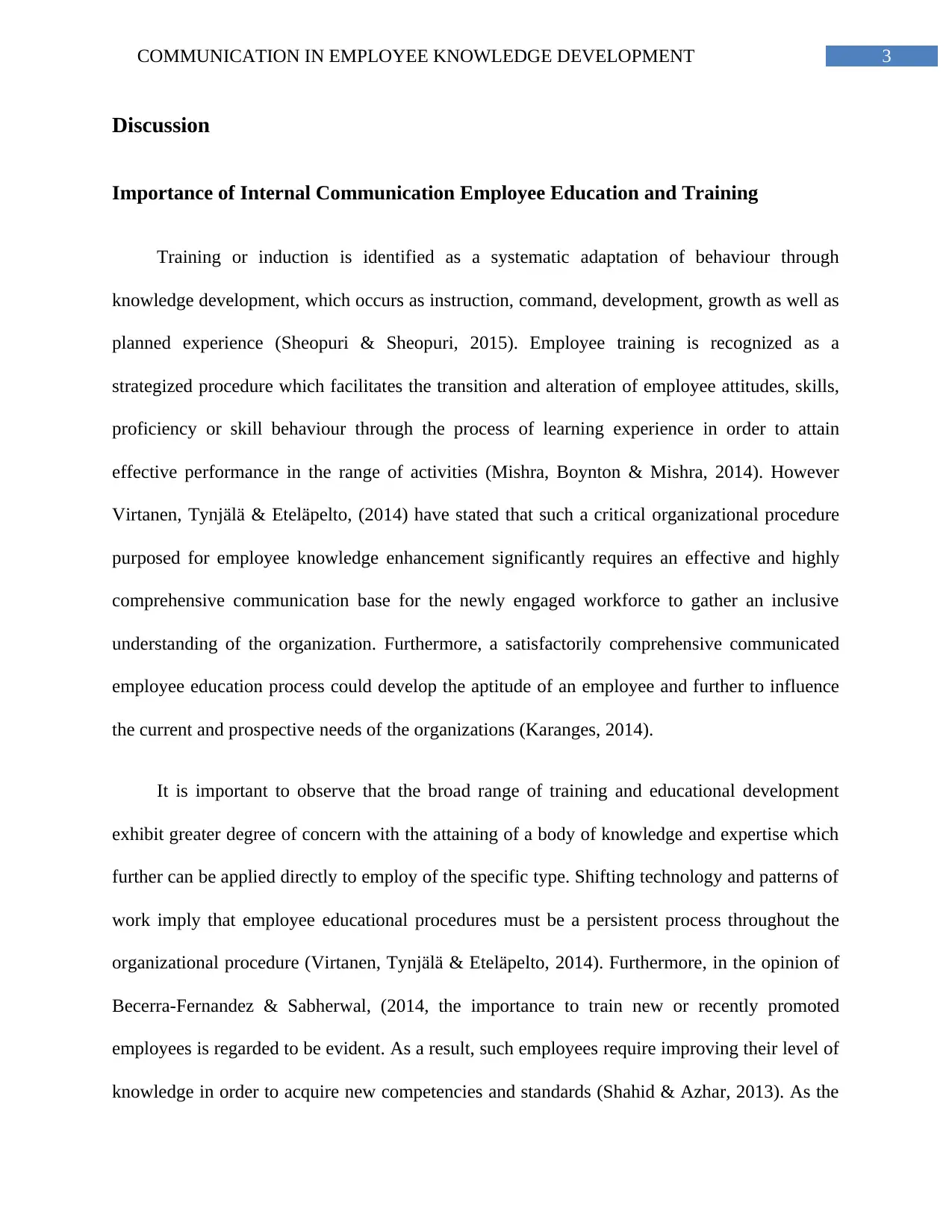
3COMMUNICATION IN EMPLOYEE KNOWLEDGE DEVELOPMENT
Discussion
Importance of Internal Communication Employee Education and Training
Training or induction is identified as a systematic adaptation of behaviour through
knowledge development, which occurs as instruction, command, development, growth as well as
planned experience (Sheopuri & Sheopuri, 2015). Employee training is recognized as a
strategized procedure which facilitates the transition and alteration of employee attitudes, skills,
proficiency or skill behaviour through the process of learning experience in order to attain
effective performance in the range of activities (Mishra, Boynton & Mishra, 2014). However
Virtanen, Tynjälä & Eteläpelto, (2014) have stated that such a critical organizational procedure
purposed for employee knowledge enhancement significantly requires an effective and highly
comprehensive communication base for the newly engaged workforce to gather an inclusive
understanding of the organization. Furthermore, a satisfactorily comprehensive communicated
employee education process could develop the aptitude of an employee and further to influence
the current and prospective needs of the organizations (Karanges, 2014).
It is important to observe that the broad range of training and educational development
exhibit greater degree of concern with the attaining of a body of knowledge and expertise which
further can be applied directly to employ of the specific type. Shifting technology and patterns of
work imply that employee educational procedures must be a persistent process throughout the
organizational procedure (Virtanen, Tynjälä & Eteläpelto, 2014). Furthermore, in the opinion of
Becerra-Fernandez & Sabherwal, (2014, the importance to train new or recently promoted
employees is regarded to be evident. As a result, such employees require improving their level of
knowledge in order to acquire new competencies and standards (Shahid & Azhar, 2013). As the
Discussion
Importance of Internal Communication Employee Education and Training
Training or induction is identified as a systematic adaptation of behaviour through
knowledge development, which occurs as instruction, command, development, growth as well as
planned experience (Sheopuri & Sheopuri, 2015). Employee training is recognized as a
strategized procedure which facilitates the transition and alteration of employee attitudes, skills,
proficiency or skill behaviour through the process of learning experience in order to attain
effective performance in the range of activities (Mishra, Boynton & Mishra, 2014). However
Virtanen, Tynjälä & Eteläpelto, (2014) have stated that such a critical organizational procedure
purposed for employee knowledge enhancement significantly requires an effective and highly
comprehensive communication base for the newly engaged workforce to gather an inclusive
understanding of the organization. Furthermore, a satisfactorily comprehensive communicated
employee education process could develop the aptitude of an employee and further to influence
the current and prospective needs of the organizations (Karanges, 2014).
It is important to observe that the broad range of training and educational development
exhibit greater degree of concern with the attaining of a body of knowledge and expertise which
further can be applied directly to employ of the specific type. Shifting technology and patterns of
work imply that employee educational procedures must be a persistent process throughout the
organizational procedure (Virtanen, Tynjälä & Eteläpelto, 2014). Furthermore, in the opinion of
Becerra-Fernandez & Sabherwal, (2014, the importance to train new or recently promoted
employees is regarded to be evident. As a result, such employees require improving their level of
knowledge in order to acquire new competencies and standards (Shahid & Azhar, 2013). As the
Paraphrase This Document
Need a fresh take? Get an instant paraphrase of this document with our AI Paraphraser
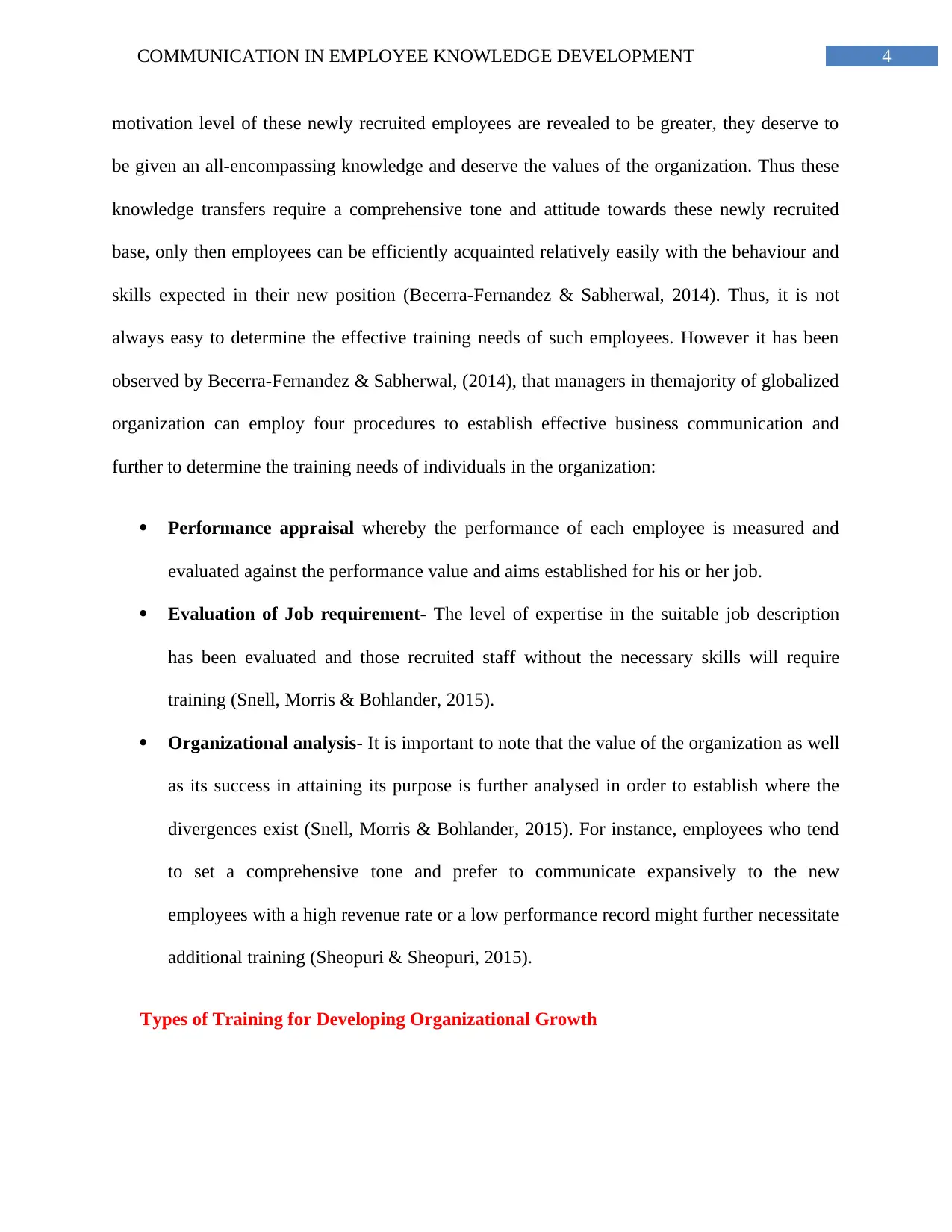
4COMMUNICATION IN EMPLOYEE KNOWLEDGE DEVELOPMENT
motivation level of these newly recruited employees are revealed to be greater, they deserve to
be given an all-encompassing knowledge and deserve the values of the organization. Thus these
knowledge transfers require a comprehensive tone and attitude towards these newly recruited
base, only then employees can be efficiently acquainted relatively easily with the behaviour and
skills expected in their new position (Becerra-Fernandez & Sabherwal, 2014). Thus, it is not
always easy to determine the effective training needs of such employees. However it has been
observed by Becerra-Fernandez & Sabherwal, (2014), that managers in themajority of globalized
organization can employ four procedures to establish effective business communication and
further to determine the training needs of individuals in the organization:
Performance appraisal whereby the performance of each employee is measured and
evaluated against the performance value and aims established for his or her job.
Evaluation of Job requirement- The level of expertise in the suitable job description
has been evaluated and those recruited staff without the necessary skills will require
training (Snell, Morris & Bohlander, 2015).
Organizational analysis- It is important to note that the value of the organization as well
as its success in attaining its purpose is further analysed in order to establish where the
divergences exist (Snell, Morris & Bohlander, 2015). For instance, employees who tend
to set a comprehensive tone and prefer to communicate expansively to the new
employees with a high revenue rate or a low performance record might further necessitate
additional training (Sheopuri & Sheopuri, 2015).
Types of Training for Developing Organizational Growth
motivation level of these newly recruited employees are revealed to be greater, they deserve to
be given an all-encompassing knowledge and deserve the values of the organization. Thus these
knowledge transfers require a comprehensive tone and attitude towards these newly recruited
base, only then employees can be efficiently acquainted relatively easily with the behaviour and
skills expected in their new position (Becerra-Fernandez & Sabherwal, 2014). Thus, it is not
always easy to determine the effective training needs of such employees. However it has been
observed by Becerra-Fernandez & Sabherwal, (2014), that managers in themajority of globalized
organization can employ four procedures to establish effective business communication and
further to determine the training needs of individuals in the organization:
Performance appraisal whereby the performance of each employee is measured and
evaluated against the performance value and aims established for his or her job.
Evaluation of Job requirement- The level of expertise in the suitable job description
has been evaluated and those recruited staff without the necessary skills will require
training (Snell, Morris & Bohlander, 2015).
Organizational analysis- It is important to note that the value of the organization as well
as its success in attaining its purpose is further analysed in order to establish where the
divergences exist (Snell, Morris & Bohlander, 2015). For instance, employees who tend
to set a comprehensive tone and prefer to communicate expansively to the new
employees with a high revenue rate or a low performance record might further necessitate
additional training (Sheopuri & Sheopuri, 2015).
Types of Training for Developing Organizational Growth
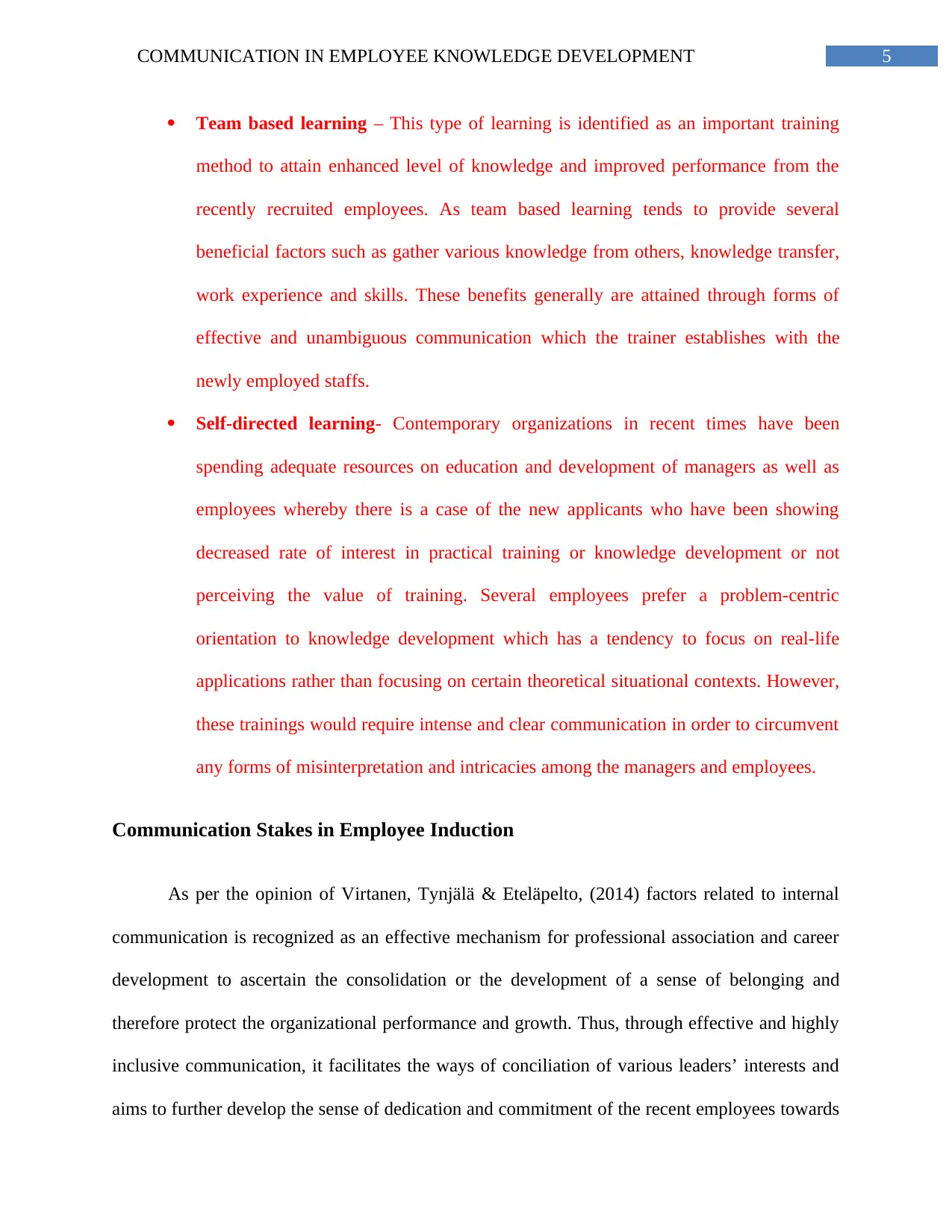
5COMMUNICATION IN EMPLOYEE KNOWLEDGE DEVELOPMENT
Team based learning – This type of learning is identified as an important training
method to attain enhanced level of knowledge and improved performance from the
recently recruited employees. As team based learning tends to provide several
beneficial factors such as gather various knowledge from others, knowledge transfer,
work experience and skills. These benefits generally are attained through forms of
effective and unambiguous communication which the trainer establishes with the
newly employed staffs.
Self-directed learning- Contemporary organizations in recent times have been
spending adequate resources on education and development of managers as well as
employees whereby there is a case of the new applicants who have been showing
decreased rate of interest in practical training or knowledge development or not
perceiving the value of training. Several employees prefer a problem-centric
orientation to knowledge development which has a tendency to focus on real-life
applications rather than focusing on certain theoretical situational contexts. However,
these trainings would require intense and clear communication in order to circumvent
any forms of misinterpretation and intricacies among the managers and employees.
Communication Stakes in Employee Induction
As per the opinion of Virtanen, Tynjälä & Eteläpelto, (2014) factors related to internal
communication is recognized as an effective mechanism for professional association and career
development to ascertain the consolidation or the development of a sense of belonging and
therefore protect the organizational performance and growth. Thus, through effective and highly
inclusive communication, it facilitates the ways of conciliation of various leaders’ interests and
aims to further develop the sense of dedication and commitment of the recent employees towards
Team based learning – This type of learning is identified as an important training
method to attain enhanced level of knowledge and improved performance from the
recently recruited employees. As team based learning tends to provide several
beneficial factors such as gather various knowledge from others, knowledge transfer,
work experience and skills. These benefits generally are attained through forms of
effective and unambiguous communication which the trainer establishes with the
newly employed staffs.
Self-directed learning- Contemporary organizations in recent times have been
spending adequate resources on education and development of managers as well as
employees whereby there is a case of the new applicants who have been showing
decreased rate of interest in practical training or knowledge development or not
perceiving the value of training. Several employees prefer a problem-centric
orientation to knowledge development which has a tendency to focus on real-life
applications rather than focusing on certain theoretical situational contexts. However,
these trainings would require intense and clear communication in order to circumvent
any forms of misinterpretation and intricacies among the managers and employees.
Communication Stakes in Employee Induction
As per the opinion of Virtanen, Tynjälä & Eteläpelto, (2014) factors related to internal
communication is recognized as an effective mechanism for professional association and career
development to ascertain the consolidation or the development of a sense of belonging and
therefore protect the organizational performance and growth. Thus, through effective and highly
inclusive communication, it facilitates the ways of conciliation of various leaders’ interests and
aims to further develop the sense of dedication and commitment of the recent employees towards
⊘ This is a preview!⊘
Do you want full access?
Subscribe today to unlock all pages.

Trusted by 1+ million students worldwide
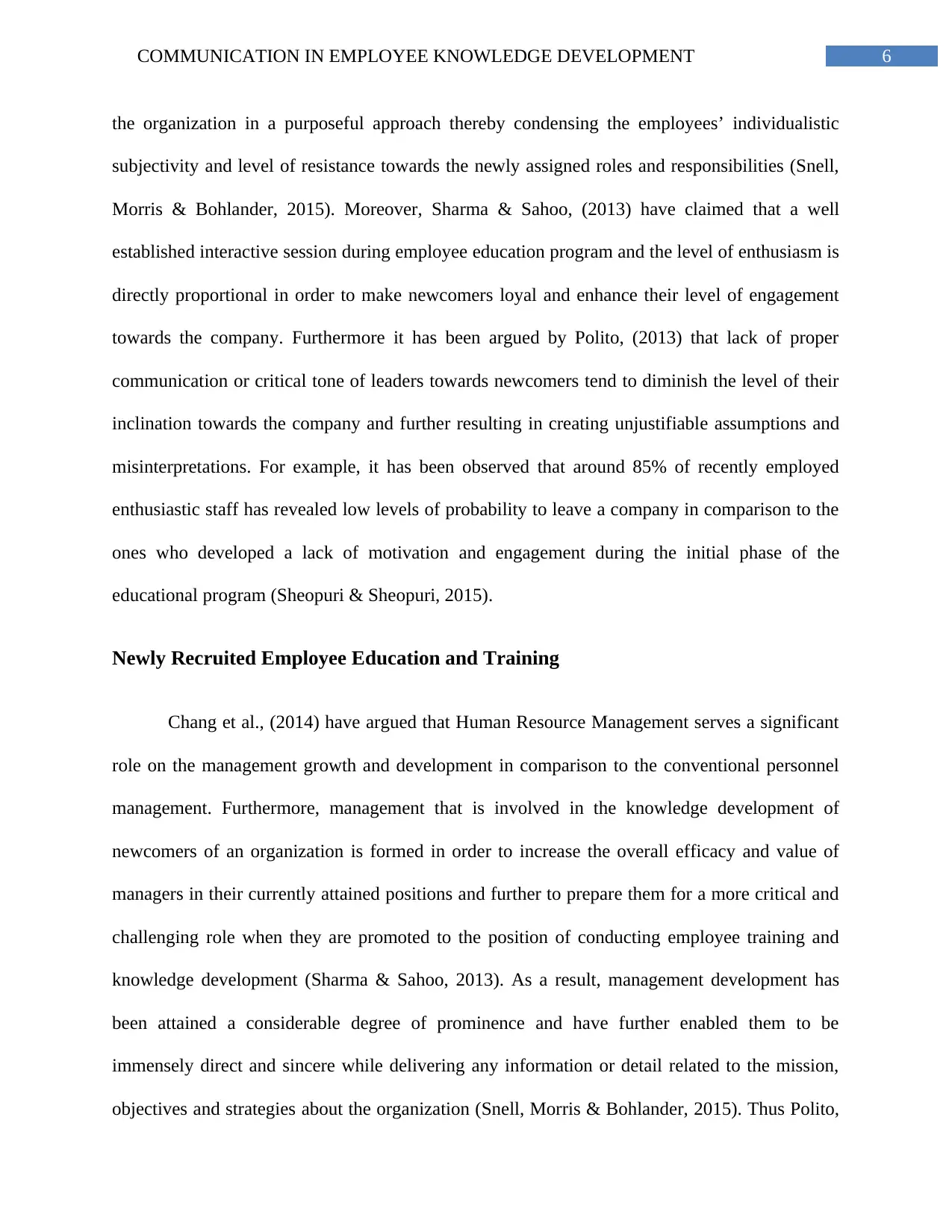
6COMMUNICATION IN EMPLOYEE KNOWLEDGE DEVELOPMENT
the organization in a purposeful approach thereby condensing the employees’ individualistic
subjectivity and level of resistance towards the newly assigned roles and responsibilities (Snell,
Morris & Bohlander, 2015). Moreover, Sharma & Sahoo, (2013) have claimed that a well
established interactive session during employee education program and the level of enthusiasm is
directly proportional in order to make newcomers loyal and enhance their level of engagement
towards the company. Furthermore it has been argued by Polito, (2013) that lack of proper
communication or critical tone of leaders towards newcomers tend to diminish the level of their
inclination towards the company and further resulting in creating unjustifiable assumptions and
misinterpretations. For example, it has been observed that around 85% of recently employed
enthusiastic staff has revealed low levels of probability to leave a company in comparison to the
ones who developed a lack of motivation and engagement during the initial phase of the
educational program (Sheopuri & Sheopuri, 2015).
Newly Recruited Employee Education and Training
Chang et al., (2014) have argued that Human Resource Management serves a significant
role on the management growth and development in comparison to the conventional personnel
management. Furthermore, management that is involved in the knowledge development of
newcomers of an organization is formed in order to increase the overall efficacy and value of
managers in their currently attained positions and further to prepare them for a more critical and
challenging role when they are promoted to the position of conducting employee training and
knowledge development (Sharma & Sahoo, 2013). As a result, management development has
been attained a considerable degree of prominence and have further enabled them to be
immensely direct and sincere while delivering any information or detail related to the mission,
objectives and strategies about the organization (Snell, Morris & Bohlander, 2015). Thus Polito,
the organization in a purposeful approach thereby condensing the employees’ individualistic
subjectivity and level of resistance towards the newly assigned roles and responsibilities (Snell,
Morris & Bohlander, 2015). Moreover, Sharma & Sahoo, (2013) have claimed that a well
established interactive session during employee education program and the level of enthusiasm is
directly proportional in order to make newcomers loyal and enhance their level of engagement
towards the company. Furthermore it has been argued by Polito, (2013) that lack of proper
communication or critical tone of leaders towards newcomers tend to diminish the level of their
inclination towards the company and further resulting in creating unjustifiable assumptions and
misinterpretations. For example, it has been observed that around 85% of recently employed
enthusiastic staff has revealed low levels of probability to leave a company in comparison to the
ones who developed a lack of motivation and engagement during the initial phase of the
educational program (Sheopuri & Sheopuri, 2015).
Newly Recruited Employee Education and Training
Chang et al., (2014) have argued that Human Resource Management serves a significant
role on the management growth and development in comparison to the conventional personnel
management. Furthermore, management that is involved in the knowledge development of
newcomers of an organization is formed in order to increase the overall efficacy and value of
managers in their currently attained positions and further to prepare them for a more critical and
challenging role when they are promoted to the position of conducting employee training and
knowledge development (Sharma & Sahoo, 2013). As a result, management development has
been attained a considerable degree of prominence and have further enabled them to be
immensely direct and sincere while delivering any information or detail related to the mission,
objectives and strategies about the organization (Snell, Morris & Bohlander, 2015). Thus Polito,
Paraphrase This Document
Need a fresh take? Get an instant paraphrase of this document with our AI Paraphraser
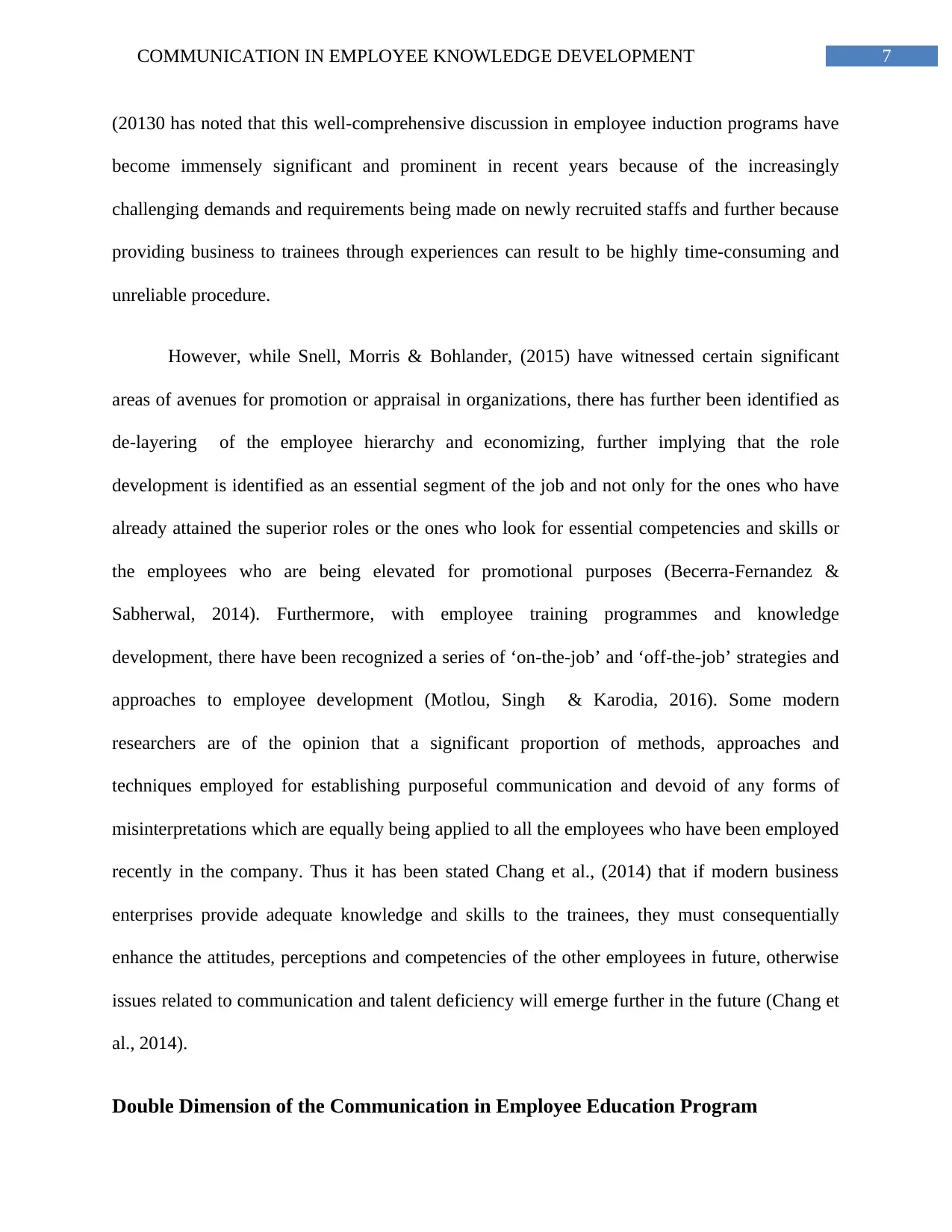
7COMMUNICATION IN EMPLOYEE KNOWLEDGE DEVELOPMENT
(20130 has noted that this well-comprehensive discussion in employee induction programs have
become immensely significant and prominent in recent years because of the increasingly
challenging demands and requirements being made on newly recruited staffs and further because
providing business to trainees through experiences can result to be highly time-consuming and
unreliable procedure.
However, while Snell, Morris & Bohlander, (2015) have witnessed certain significant
areas of avenues for promotion or appraisal in organizations, there has further been identified as
de-layering of the employee hierarchy and economizing, further implying that the role
development is identified as an essential segment of the job and not only for the ones who have
already attained the superior roles or the ones who look for essential competencies and skills or
the employees who are being elevated for promotional purposes (Becerra-Fernandez &
Sabherwal, 2014). Furthermore, with employee training programmes and knowledge
development, there have been recognized a series of ‘on-the-job’ and ‘off-the-job’ strategies and
approaches to employee development (Motlou, Singh & Karodia, 2016). Some modern
researchers are of the opinion that a significant proportion of methods, approaches and
techniques employed for establishing purposeful communication and devoid of any forms of
misinterpretations which are equally being applied to all the employees who have been employed
recently in the company. Thus it has been stated Chang et al., (2014) that if modern business
enterprises provide adequate knowledge and skills to the trainees, they must consequentially
enhance the attitudes, perceptions and competencies of the other employees in future, otherwise
issues related to communication and talent deficiency will emerge further in the future (Chang et
al., 2014).
Double Dimension of the Communication in Employee Education Program
(20130 has noted that this well-comprehensive discussion in employee induction programs have
become immensely significant and prominent in recent years because of the increasingly
challenging demands and requirements being made on newly recruited staffs and further because
providing business to trainees through experiences can result to be highly time-consuming and
unreliable procedure.
However, while Snell, Morris & Bohlander, (2015) have witnessed certain significant
areas of avenues for promotion or appraisal in organizations, there has further been identified as
de-layering of the employee hierarchy and economizing, further implying that the role
development is identified as an essential segment of the job and not only for the ones who have
already attained the superior roles or the ones who look for essential competencies and skills or
the employees who are being elevated for promotional purposes (Becerra-Fernandez &
Sabherwal, 2014). Furthermore, with employee training programmes and knowledge
development, there have been recognized a series of ‘on-the-job’ and ‘off-the-job’ strategies and
approaches to employee development (Motlou, Singh & Karodia, 2016). Some modern
researchers are of the opinion that a significant proportion of methods, approaches and
techniques employed for establishing purposeful communication and devoid of any forms of
misinterpretations which are equally being applied to all the employees who have been employed
recently in the company. Thus it has been stated Chang et al., (2014) that if modern business
enterprises provide adequate knowledge and skills to the trainees, they must consequentially
enhance the attitudes, perceptions and competencies of the other employees in future, otherwise
issues related to communication and talent deficiency will emerge further in the future (Chang et
al., 2014).
Double Dimension of the Communication in Employee Education Program
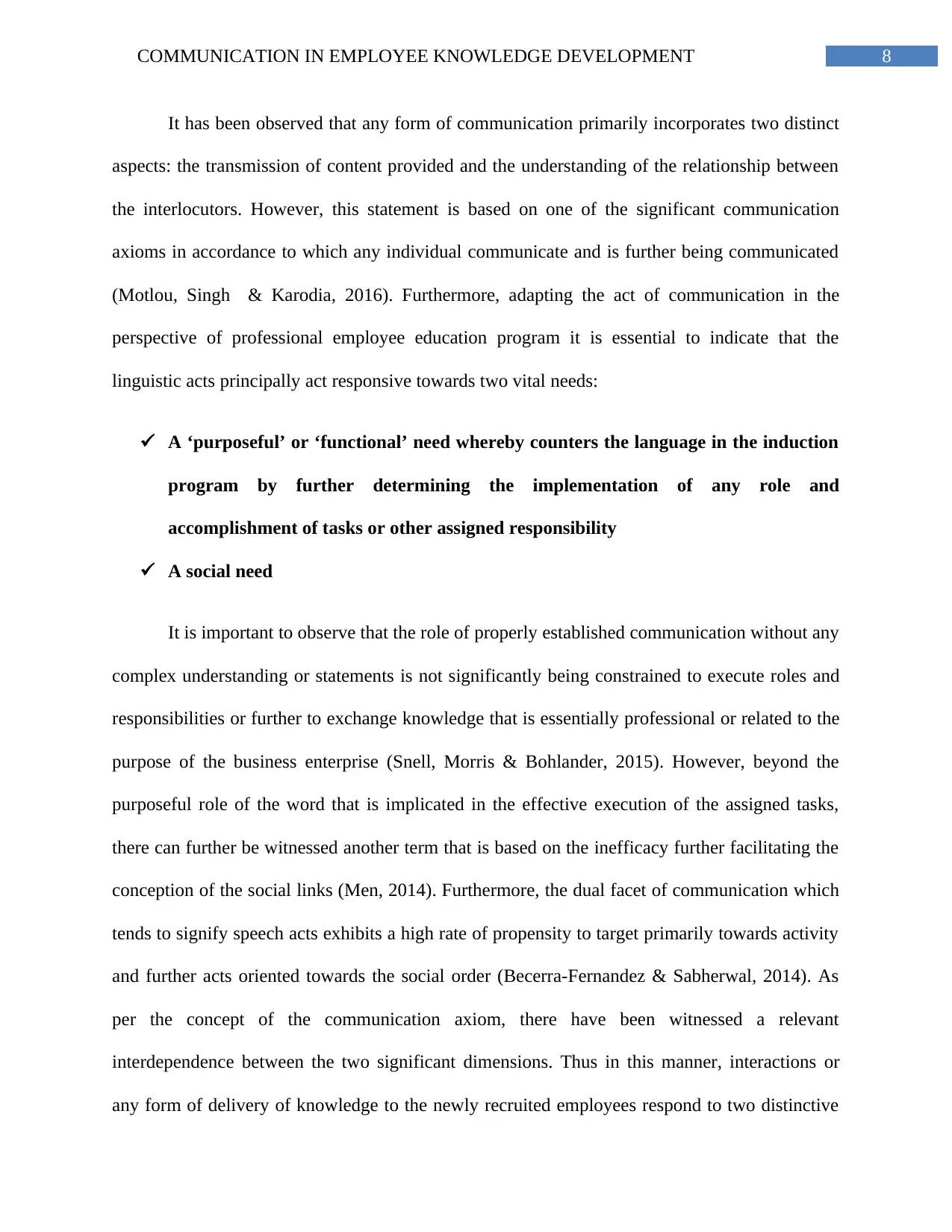
8COMMUNICATION IN EMPLOYEE KNOWLEDGE DEVELOPMENT
It has been observed that any form of communication primarily incorporates two distinct
aspects: the transmission of content provided and the understanding of the relationship between
the interlocutors. However, this statement is based on one of the significant communication
axioms in accordance to which any individual communicate and is further being communicated
(Motlou, Singh & Karodia, 2016). Furthermore, adapting the act of communication in the
perspective of professional employee education program it is essential to indicate that the
linguistic acts principally act responsive towards two vital needs:
A ‘purposeful’ or ‘functional’ need whereby counters the language in the induction
program by further determining the implementation of any role and
accomplishment of tasks or other assigned responsibility
A social need
It is important to observe that the role of properly established communication without any
complex understanding or statements is not significantly being constrained to execute roles and
responsibilities or further to exchange knowledge that is essentially professional or related to the
purpose of the business enterprise (Snell, Morris & Bohlander, 2015). However, beyond the
purposeful role of the word that is implicated in the effective execution of the assigned tasks,
there can further be witnessed another term that is based on the inefficacy further facilitating the
conception of the social links (Men, 2014). Furthermore, the dual facet of communication which
tends to signify speech acts exhibits a high rate of propensity to target primarily towards activity
and further acts oriented towards the social order (Becerra-Fernandez & Sabherwal, 2014). As
per the concept of the communication axiom, there have been witnessed a relevant
interdependence between the two significant dimensions. Thus in this manner, interactions or
any form of delivery of knowledge to the newly recruited employees respond to two distinctive
It has been observed that any form of communication primarily incorporates two distinct
aspects: the transmission of content provided and the understanding of the relationship between
the interlocutors. However, this statement is based on one of the significant communication
axioms in accordance to which any individual communicate and is further being communicated
(Motlou, Singh & Karodia, 2016). Furthermore, adapting the act of communication in the
perspective of professional employee education program it is essential to indicate that the
linguistic acts principally act responsive towards two vital needs:
A ‘purposeful’ or ‘functional’ need whereby counters the language in the induction
program by further determining the implementation of any role and
accomplishment of tasks or other assigned responsibility
A social need
It is important to observe that the role of properly established communication without any
complex understanding or statements is not significantly being constrained to execute roles and
responsibilities or further to exchange knowledge that is essentially professional or related to the
purpose of the business enterprise (Snell, Morris & Bohlander, 2015). However, beyond the
purposeful role of the word that is implicated in the effective execution of the assigned tasks,
there can further be witnessed another term that is based on the inefficacy further facilitating the
conception of the social links (Men, 2014). Furthermore, the dual facet of communication which
tends to signify speech acts exhibits a high rate of propensity to target primarily towards activity
and further acts oriented towards the social order (Becerra-Fernandez & Sabherwal, 2014). As
per the concept of the communication axiom, there have been witnessed a relevant
interdependence between the two significant dimensions. Thus in this manner, interactions or
any form of delivery of knowledge to the newly recruited employees respond to two distinctive
⊘ This is a preview!⊘
Do you want full access?
Subscribe today to unlock all pages.

Trusted by 1+ million students worldwide
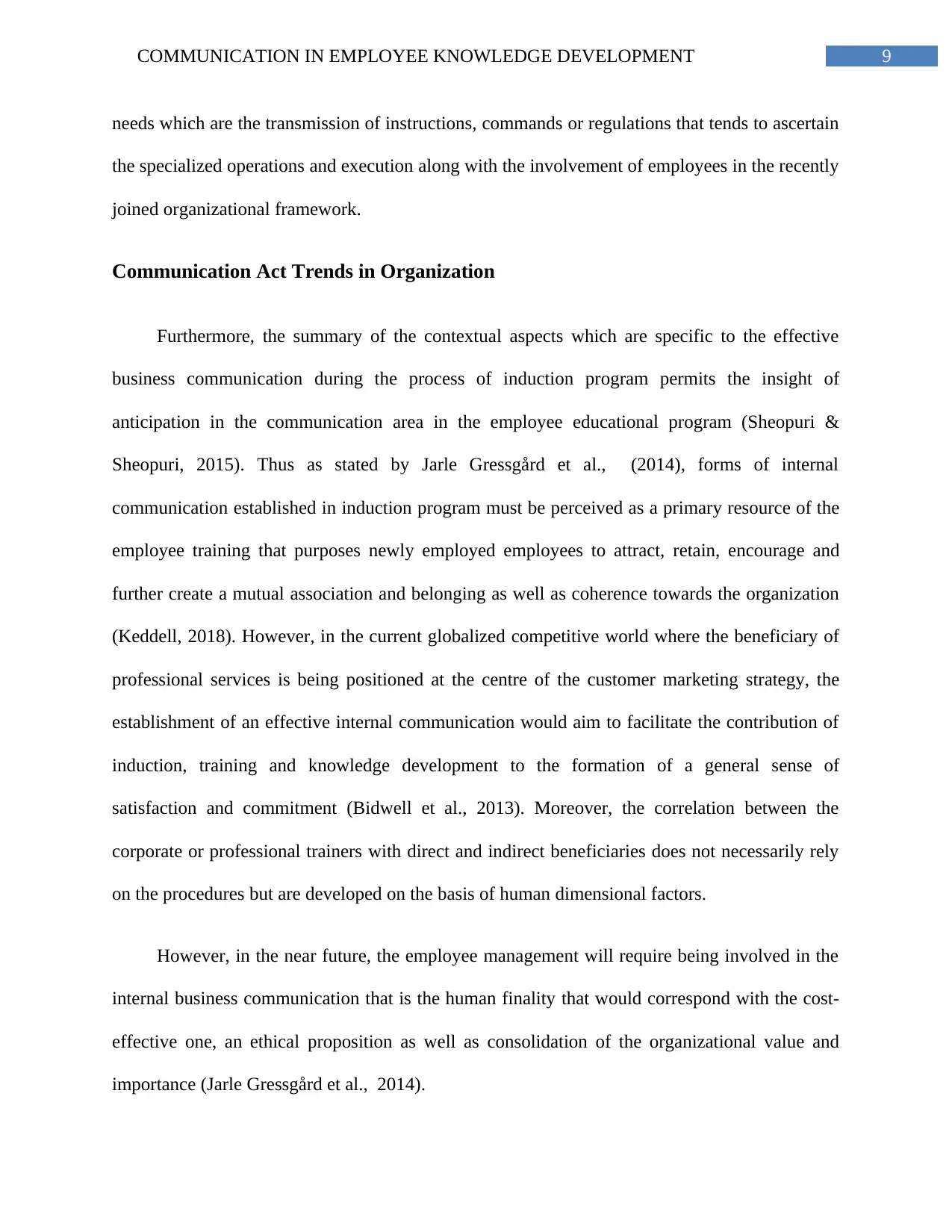
9COMMUNICATION IN EMPLOYEE KNOWLEDGE DEVELOPMENT
needs which are the transmission of instructions, commands or regulations that tends to ascertain
the specialized operations and execution along with the involvement of employees in the recently
joined organizational framework.
Communication Act Trends in Organization
Furthermore, the summary of the contextual aspects which are specific to the effective
business communication during the process of induction program permits the insight of
anticipation in the communication area in the employee educational program (Sheopuri &
Sheopuri, 2015). Thus as stated by Jarle Gressgård et al., (2014), forms of internal
communication established in induction program must be perceived as a primary resource of the
employee training that purposes newly employed employees to attract, retain, encourage and
further create a mutual association and belonging as well as coherence towards the organization
(Keddell, 2018). However, in the current globalized competitive world where the beneficiary of
professional services is being positioned at the centre of the customer marketing strategy, the
establishment of an effective internal communication would aim to facilitate the contribution of
induction, training and knowledge development to the formation of a general sense of
satisfaction and commitment (Bidwell et al., 2013). Moreover, the correlation between the
corporate or professional trainers with direct and indirect beneficiaries does not necessarily rely
on the procedures but are developed on the basis of human dimensional factors.
However, in the near future, the employee management will require being involved in the
internal business communication that is the human finality that would correspond with the cost-
effective one, an ethical proposition as well as consolidation of the organizational value and
importance (Jarle Gressgård et al., 2014).
needs which are the transmission of instructions, commands or regulations that tends to ascertain
the specialized operations and execution along with the involvement of employees in the recently
joined organizational framework.
Communication Act Trends in Organization
Furthermore, the summary of the contextual aspects which are specific to the effective
business communication during the process of induction program permits the insight of
anticipation in the communication area in the employee educational program (Sheopuri &
Sheopuri, 2015). Thus as stated by Jarle Gressgård et al., (2014), forms of internal
communication established in induction program must be perceived as a primary resource of the
employee training that purposes newly employed employees to attract, retain, encourage and
further create a mutual association and belonging as well as coherence towards the organization
(Keddell, 2018). However, in the current globalized competitive world where the beneficiary of
professional services is being positioned at the centre of the customer marketing strategy, the
establishment of an effective internal communication would aim to facilitate the contribution of
induction, training and knowledge development to the formation of a general sense of
satisfaction and commitment (Bidwell et al., 2013). Moreover, the correlation between the
corporate or professional trainers with direct and indirect beneficiaries does not necessarily rely
on the procedures but are developed on the basis of human dimensional factors.
However, in the near future, the employee management will require being involved in the
internal business communication that is the human finality that would correspond with the cost-
effective one, an ethical proposition as well as consolidation of the organizational value and
importance (Jarle Gressgård et al., 2014).
Paraphrase This Document
Need a fresh take? Get an instant paraphrase of this document with our AI Paraphraser
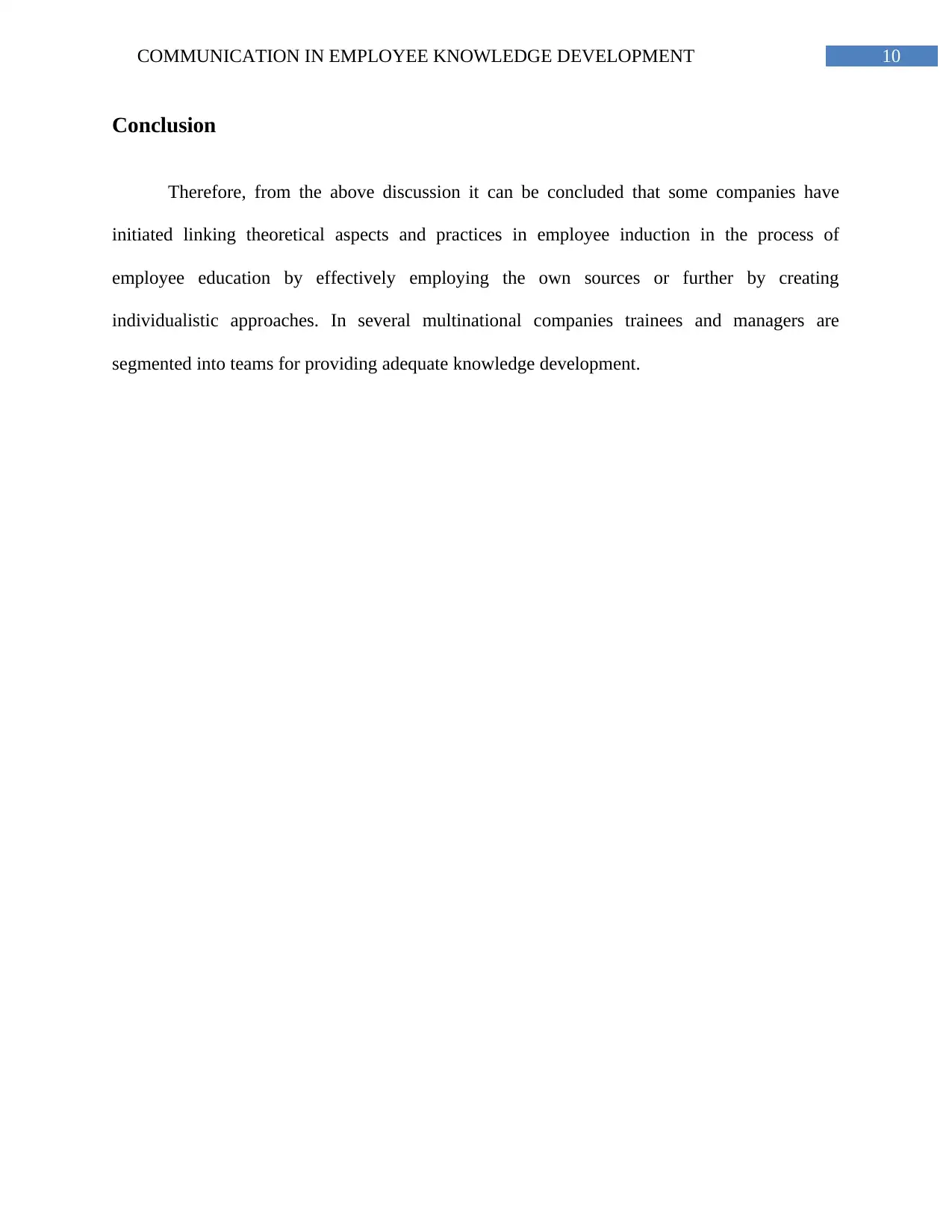
10COMMUNICATION IN EMPLOYEE KNOWLEDGE DEVELOPMENT
Conclusion
Therefore, from the above discussion it can be concluded that some companies have
initiated linking theoretical aspects and practices in employee induction in the process of
employee education by effectively employing the own sources or further by creating
individualistic approaches. In several multinational companies trainees and managers are
segmented into teams for providing adequate knowledge development.
Conclusion
Therefore, from the above discussion it can be concluded that some companies have
initiated linking theoretical aspects and practices in employee induction in the process of
employee education by effectively employing the own sources or further by creating
individualistic approaches. In several multinational companies trainees and managers are
segmented into teams for providing adequate knowledge development.
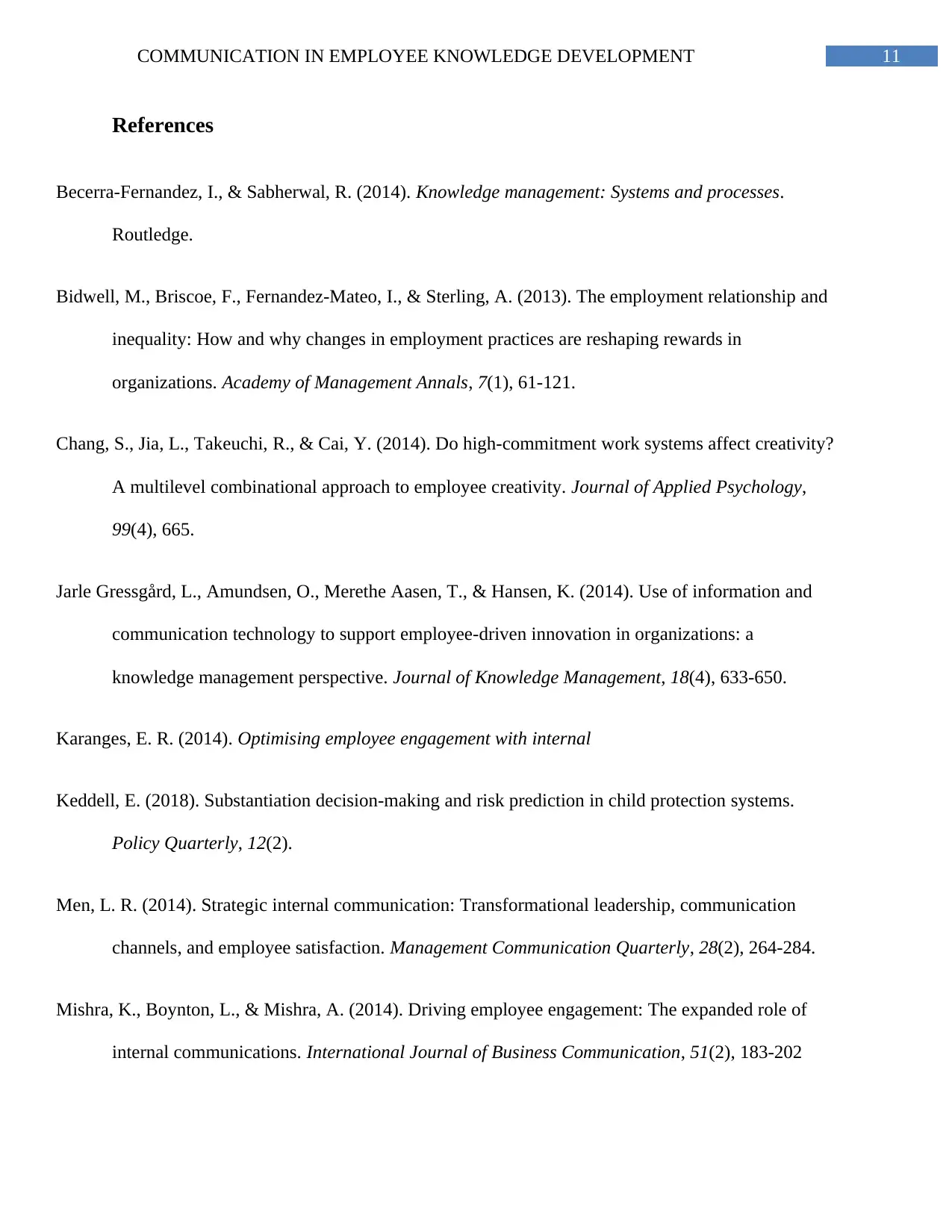
11COMMUNICATION IN EMPLOYEE KNOWLEDGE DEVELOPMENT
References
Becerra-Fernandez, I., & Sabherwal, R. (2014). Knowledge management: Systems and processes.
Routledge.
Bidwell, M., Briscoe, F., Fernandez-Mateo, I., & Sterling, A. (2013). The employment relationship and
inequality: How and why changes in employment practices are reshaping rewards in
organizations. Academy of Management Annals, 7(1), 61-121.
Chang, S., Jia, L., Takeuchi, R., & Cai, Y. (2014). Do high-commitment work systems affect creativity?
A multilevel combinational approach to employee creativity. Journal of Applied Psychology,
99(4), 665.
Jarle Gressgård, L., Amundsen, O., Merethe Aasen, T., & Hansen, K. (2014). Use of information and
communication technology to support employee-driven innovation in organizations: a
knowledge management perspective. Journal of Knowledge Management, 18(4), 633-650.
Karanges, E. R. (2014). Optimising employee engagement with internal
Keddell, E. (2018). Substantiation decision-making and risk prediction in child protection systems.
Policy Quarterly, 12(2).
Men, L. R. (2014). Strategic internal communication: Transformational leadership, communication
channels, and employee satisfaction. Management Communication Quarterly, 28(2), 264-284.
Mishra, K., Boynton, L., & Mishra, A. (2014). Driving employee engagement: The expanded role of
internal communications. International Journal of Business Communication, 51(2), 183-202
References
Becerra-Fernandez, I., & Sabherwal, R. (2014). Knowledge management: Systems and processes.
Routledge.
Bidwell, M., Briscoe, F., Fernandez-Mateo, I., & Sterling, A. (2013). The employment relationship and
inequality: How and why changes in employment practices are reshaping rewards in
organizations. Academy of Management Annals, 7(1), 61-121.
Chang, S., Jia, L., Takeuchi, R., & Cai, Y. (2014). Do high-commitment work systems affect creativity?
A multilevel combinational approach to employee creativity. Journal of Applied Psychology,
99(4), 665.
Jarle Gressgård, L., Amundsen, O., Merethe Aasen, T., & Hansen, K. (2014). Use of information and
communication technology to support employee-driven innovation in organizations: a
knowledge management perspective. Journal of Knowledge Management, 18(4), 633-650.
Karanges, E. R. (2014). Optimising employee engagement with internal
Keddell, E. (2018). Substantiation decision-making and risk prediction in child protection systems.
Policy Quarterly, 12(2).
Men, L. R. (2014). Strategic internal communication: Transformational leadership, communication
channels, and employee satisfaction. Management Communication Quarterly, 28(2), 264-284.
Mishra, K., Boynton, L., & Mishra, A. (2014). Driving employee engagement: The expanded role of
internal communications. International Journal of Business Communication, 51(2), 183-202
⊘ This is a preview!⊘
Do you want full access?
Subscribe today to unlock all pages.

Trusted by 1+ million students worldwide
1 out of 13
Related Documents
Your All-in-One AI-Powered Toolkit for Academic Success.
+13062052269
info@desklib.com
Available 24*7 on WhatsApp / Email
![[object Object]](/_next/static/media/star-bottom.7253800d.svg)
Unlock your academic potential
Copyright © 2020–2025 A2Z Services. All Rights Reserved. Developed and managed by ZUCOL.





